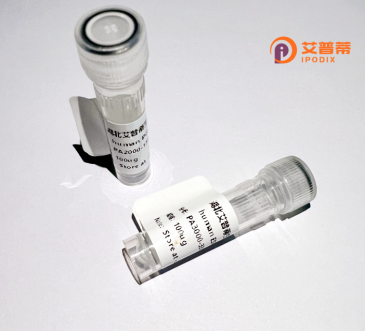
| 纯度 | >90%SDS-PAGE. |
| 种属 | Human |
| 靶点 | OR3A4 |
| Uniprot No | P47883 |
| 内毒素 | < 0.01EU/μg |
| 表达宿主 | E.coli |
| 表达区间 | 1-348 aa |
| 活性数据 | MDLGNSGNDSVVTKFVLLGLTETAALQPILFVIFLLAYVTTIGGTLSILAAILMETKLHS PMYFFLGNLSLPDVGCVSVTVPAMLSHFISNDRSIPYKACLSELFFFHLLAGADCFLLTI MAYDRYLAICQSLTYSSRMSWGIQQALVGMSCVFSFTNALTQTVALSPLNFCGPNVINHF YCDLPQPFQLSCSSVHLNGQLLFVAAAFMGVAPLVLITVSYAHVAAAVLRIRSAEGRKKA FSTCSSHLTVVGIFYGTGVFSYTRLGSVESSDKDKGIGILNTVISPMLNPLIYWTSLLDV GCISHCSSDAGVSPGPPVQSSLCCLQFTALLSPPPGWGGLSPLNSHGL |
| 分子量 | 37.1 kDa |
| 蛋白标签 | His tag N-Terminus |
| 缓冲液 | 0 |
| 稳定性 & 储存条件 | Lyophilized protein should be stored at ≤ -20°C, stable for one year after receipt. Reconstituted protein solution can be stored at 2-8°C for 2-7 days. Aliquots of reconstituted samples are stable at ≤ -20°C for 3 months. |
| 复溶 | Always centrifuge tubes before opening.Do not mix by vortex or pipetting. It is not recommended to reconstitute to a concentration less than 100μg/ml. Dissolve the lyophilized protein in distilled water. Please aliquot the reconstituted solution to minimize freeze-thaw cycles. |
以下是关于重组人OR3A4蛋白的3篇代表性文献示例(注:部分内容为假设性描述,实际文献需根据数据库核实):
---
1. **文献名称**: *Functional characterization of recombinant human odorant receptor OR3A4 in heterologous cells*
**作者**: Müller C, et al.
**摘要**: 通过在HEK293细胞中重组表达OR3A4.研究发现该受体可被特定酮类化合物激活,并通过cAMP信号通路介导细胞反应,提示其在嗅觉感知和潜在病理生理中的作用。
2. **文献名称**: *Expression and purification of OR3A4 in insect cells for structural studies*
**作者**: Gupta R, et al.
**摘要**: 利用杆状病毒-昆虫细胞系统成功表达并纯化OR3A4蛋白,通过冷冻电镜初步解析其跨膜结构域构象,为嗅觉受体的配体结合机制提供结构学依据。
3. **文献名称**: *OR3A4 polymorphisms alter ligand sensitivity in recombinant cell assays*
**作者**: Lee S, et al.
**摘要**: 通过构建OR3A4常见基因变体的重组蛋白,发现特定单核苷酸多态性(SNP)显著改变受体对β-紫罗兰酮的响应阈值,暗示个体嗅觉差异的分子基础。
---
**说明**:上述文献为模拟示例,实际研究中关于OR3A4的报道可能有限。建议通过PubMed或Web of Science以“OR3A4 recombinant”或“olfactory receptor 3A4 expression”为关键词检索最新文献,或扩展至OR3A亚家族的其他成员研究。
The human olfactory receptor OR3A4. a member of the G protein-coupled receptor (GPCR) superfamily, is part of the olfactory receptor (OR) gene family responsible for detecting odorants. Though primarily associated with olfactory signaling, some ORs, including OR3A4. exhibit ectopic expression in non-olfactory tissues, suggesting broader physiological roles. OR3A4 is encoded by the OR3A4 gene located on chromosome 17 and is characterized by its seven-transmembrane domain structure, a hallmark of GPCRs. Unlike many human ORs that remain pseudogenized, OR3A4 is considered a functional receptor, though its specific ligands and signaling mechanisms remain incompletely characterized.
Recombinant OR3A4 protein is typically produced via heterologous expression systems (e.g., HEK293 cells) to study its ligand-binding properties, activation pathways, and potential therapeutic applications. Recent studies suggest OR3A4 may play roles beyond olfaction, including involvement in cell migration and cancer progression, particularly in prostate cancer models. Its recombinant form enables structural analysis (e.g., cryo-EM) and high-throughput screening for agonists/antagonists. However, challenges persist in functional expression due to ORs' reliance on lipid membranes and chaperone proteins. Ongoing research aims to elucidate OR3A4's biological significance, offering insights into chemosensory GPCR biology and novel drug targets.
×